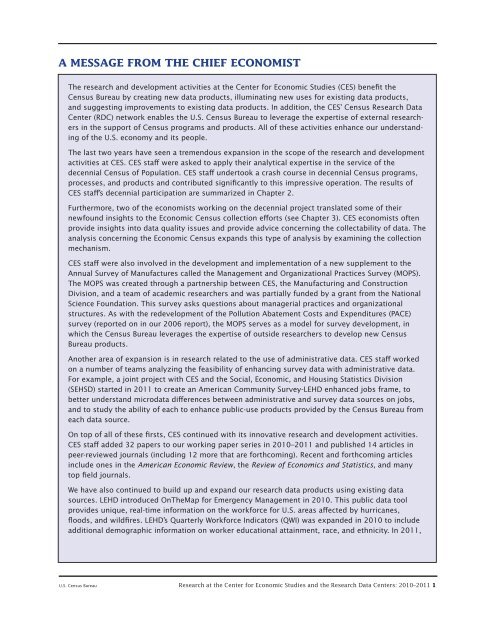2010 and 2011 - Census Bureau
2010 and 2011 - Census Bureau
2010 and 2011 - Census Bureau
Create successful ePaper yourself
Turn your PDF publications into a flip-book with our unique Google optimized e-Paper software.
A MessAge FroM tHe cHieF econoMist<br />
The research <strong>and</strong> development activities at the Center for Economic Studies (CES) benefit the<br />
<strong>Census</strong> <strong>Bureau</strong> by creating new data products, illuminating new uses for existing data products,<br />
<strong>and</strong> suggesting improvements to existing data products. In addition, the CES’ <strong>Census</strong> Research Data<br />
Center (RDC) network enables the U.S. <strong>Census</strong> <strong>Bureau</strong> to leverage the expertise of external researchers<br />
in the support of <strong>Census</strong> programs <strong>and</strong> products. All of these activities enhance our underst<strong>and</strong>ing<br />
of the U.S. economy <strong>and</strong> its people.<br />
The last two years have seen a tremendous expansion in the scope of the research <strong>and</strong> development<br />
activities at CES. CES staff were asked to apply their analytical expertise in the service of the<br />
decennial <strong>Census</strong> of Population. CES staff undertook a crash course in decennial <strong>Census</strong> programs,<br />
processes, <strong>and</strong> products <strong>and</strong> contributed significantly to this impressive operation. The results of<br />
CES staff’s decennial participation are summarized in Chapter 2.<br />
Furthermore, two of the economists working on the decennial project translated some of their<br />
newfound insights to the Economic <strong>Census</strong> collection efforts (see Chapter 3). CES economists often<br />
provide insights into data quality issues <strong>and</strong> provide advice concerning the collectability of data. The<br />
analysis concerning the Economic <strong>Census</strong> exp<strong>and</strong>s this type of analysis by examining the collection<br />
mechanism.<br />
CES staff were also involved in the development <strong>and</strong> implementation of a new supplement to the<br />
Annual Survey of Manufactures called the Management <strong>and</strong> Organizational Practices Survey (MOPS).<br />
The MOPS was created through a partnership between CES, the Manufacturing <strong>and</strong> Construction<br />
Division, <strong>and</strong> a team of academic researchers <strong>and</strong> was partially funded by a grant from the National<br />
Science Foundation. This survey asks questions about managerial practices <strong>and</strong> organizational<br />
structures. As with the redevelopment of the Pollution Abatement Costs <strong>and</strong> Expenditures (PACE)<br />
survey (reported on in our 2006 report), the MOPS serves as a model for survey development, in<br />
which the <strong>Census</strong> <strong>Bureau</strong> leverages the expertise of outside researchers to develop new <strong>Census</strong><br />
<strong>Bureau</strong> products.<br />
Another area of expansion is in research related to the use of administrative data. CES staff worked<br />
on a number of teams analyzing the feasibility of enhancing survey data with administrative data.<br />
For example, a joint project with CES <strong>and</strong> the Social, Economic, <strong>and</strong> Housing Statistics Division<br />
(SEHSD) started in <strong>2011</strong> to create an American Community Survey-LEHD enhanced jobs frame, to<br />
better underst<strong>and</strong> microdata differences between administrative <strong>and</strong> survey data sources on jobs,<br />
<strong>and</strong> to study the ability of each to enhance public-use products provided by the <strong>Census</strong> <strong>Bureau</strong> from<br />
each data source.<br />
On top of all of these firsts, CES continued with its innovative research <strong>and</strong> development activities.<br />
CES staff added 32 papers to our working paper series in <strong>2010</strong>–<strong>2011</strong> <strong>and</strong> published 14 articles in<br />
peer-reviewed journals (including 12 more that are forthcoming). Recent <strong>and</strong> forthcoming articles<br />
include ones in the American Economic Review, the Review of Economics <strong>and</strong> Statistics, <strong>and</strong> many<br />
top field journals.<br />
We have also continued to build up <strong>and</strong> exp<strong>and</strong> our research data products using existing data<br />
sources. LEHD introduced OnTheMap for Emergency Management in <strong>2010</strong>. This public data tool<br />
provides unique, real-time information on the workforce for U.S. areas affected by hurricanes,<br />
floods, <strong>and</strong> wildfires. LEHD’s Quarterly Workforce Indicators (QWI) was exp<strong>and</strong>ed in <strong>2010</strong> to include<br />
additional demographic information on worker educational attainment, race, <strong>and</strong> ethnicity. In <strong>2011</strong>,<br />
U.S. <strong>Census</strong> <strong>Bureau</strong> Research at the Center for Economic Studies <strong>and</strong> the Research Data Centers: <strong>2010</strong>–<strong>2011</strong> 1

















